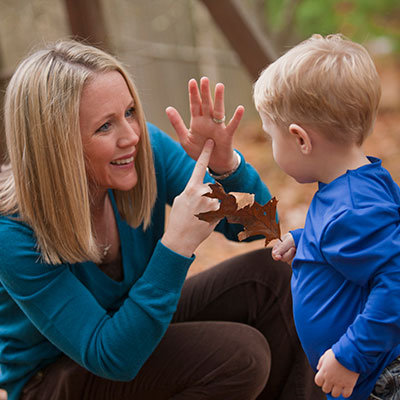You know your baby may not understand sign language yet, but the closeness, attention, and bright, interesting colors and shapes are still exciting. Best of all, your baby has your undivided attention.
When you are sharing a book,
keep the book visible and your signs visible.
How can you do that? Most books for small children will stay open.
- Try putting the book on a pillow and your baby in your lap – your baby will be able to see your signs and the book
- Sit side by side on the couch or floor and make your signs right on the book itself
- If your baby is in a high chair, you can put the book on the tray and share the story (if you can read and look at pictures upside down!)
- View examples of holding a book while signing.
Where do you and your baby like to sit and have conversations? Take your books there. Just be sure the child can see your face, the signs, and the book.

Notice how the adult is right on the infant’s eye level. This is a good position for signing a story.
Look for Popular Stories in American Sign Language (ASL)
Many popular children’s stories have been translated into American Sign Language and can be accessed online. Why are these helpful?
- The storytellers on the tapes mesmerize even very young deaf children
- When you get the actual books out to read, your child will be excited to see a familiar story and ready to communicate about it with you.
- It is helpful to watch how fluent signers tell stories. You can learn from the approaches they use.
Here is a link to signed stories available online:
-
American Society for Deaf Children: has a wonderful collection of children’s stories in American Sign Language. Visit
this site for access to this helpful resource
Find Deaf Adults to Read with Your Family
Some states offer a Shared Reading Program led by Deaf adults (check the
Laurent Clerc National Deaf Education Center at Gallaudet University for more information). If this program is not available in your area, you may be able to find opportunities to meet Deaf adults who can help you learn to read and tell stories.
- As you make new Deaf friends, invite them to become part of your baby's book experience.
- You will have a chance to see all the ways that communication about books can happen.
- For example, Deaf adults will communicate with facial expressions, role-playing, pointing and gestures, and signs.
- Your baby will have a chance to see more than one person reading and to communicate with more than one person about books.
- For additional information on reading and signing stories, visit the
American Society for Deaf Children website.
Here we see a Deaf adult signing about some simple pictures for a young child. Notice how expressive her face is! Deaf adults have much to share about ways to make the words visually interesting!! Ask your early intervention program how to access Deaf adults in your community.
She signs "mouse," and then shows how the mouse is looking off in the distance, and later starts to nibble on a paper. Notice that both her face and her signs convey feelings and actions.
Read Stories Over and Over
Every time you and your baby share a book, you will feel more confident about telling the story and about your conversations.
- Your baby will remember what is going to happen
- She will wait to see the funny expression on your face, or to catch that new word or phrase that is so much fun to sign along with you
- Your baby will learn something new with every reading
See this YouTube clip of a little one signing at a young age! It shows the benefits of being read to early!